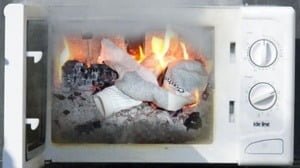
Fire Safety Tips for Using Microwave Ovens
Actualizado a fecha: 2 December, 2018
We have already discussed about lacks in fire prevention in homes, generally in neighborhoods, and today we will refer to the appliance that less attention usually receives, and that is why it usually causes more problems: the microwaves
Fire Safety Tips for Using Microwave Ovens
– Purcahse a microwave oven that is listed by a qaulified testing laboratory. Make sure to complete and return the product registration card. This way the manufacturer can reach you if there is a recall on the product.
– Plug the microwave oven directly into the walloutlet — never use an extension cord.
– Make sure the microwave oven is at a safe height, within easy reach of all users.
– Open food slowly, away from the face. Hot steam or the food itself can cause burns.
– Food heats unevenly in microwave ovens. Stir and test before eating or giving to children.
– Never heat a baby bottle in the microwave. Since a microwave oven heats unevenly, it can create hot pockets, leading to burns. Warm a bottle in a bowl of warm — not hot or boiling — water, or by running it under the tap.
MICROWAVE USE
Always supervise children when they are using a microwave oven.
Use only microwave-safe food containers or dishes. Never use aluminum foil or metal in a microwave oven.
If you have a fire in the microwave, leave the door closed, turn the oven off and unplug it from the wall. If the fire does not go out, get outside and call the fire department.
Microwave Oven Safety
With busy lives, families rely on the microwave oven as a quick way to heat up a meal, warm up a drink or defrost dinner. While the convenience of the microwave oven is something we take for granted, safety should not be. By following a few simple safety tips you can prevent painful burns and possible fires.
Do not never put inside the microwave:
– Foil
– Tetra-brick receptacles
– Cutlery and other metal kitchen utensils
– Screen-printed old plates and tableware
– Alcohol or beverages containing it
– Unbreakable eggs and fatty skin foods
– Chillies
– Carrots
Source: NFPA